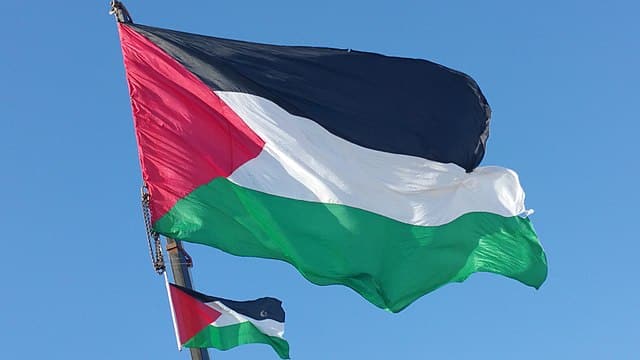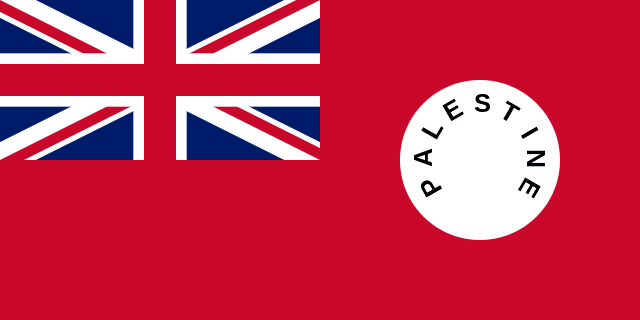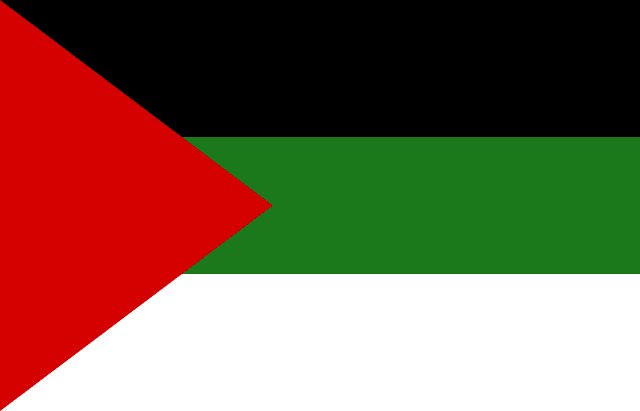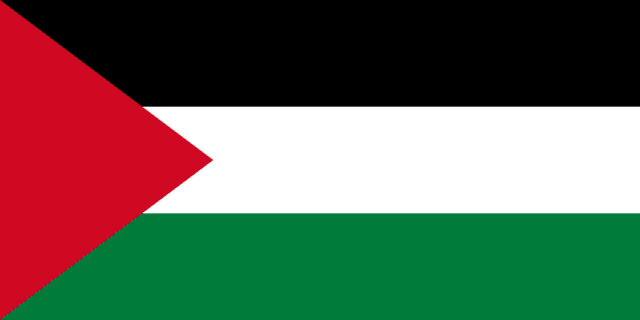Contents
The history of the Palestinian flag predates that of the country by a great margin and is way older than the country itself. Many elements of the design are common to the flags of other Arab countries since it is clearly a descendant of the flag of the Arab Revolt. The flag serves as a historic representation of the nation of Palestine and the Palestinian people.
In the article below, we will explore the flag that has deep, centuries-old historical origins despite being officially adopted in the late 1960s.
Characteristics Of Palestine
The history of the Palestine flag is intertwined with the geography and demographic characteristics of the country. Palestine is a small area of territory, yet it has been important to the Middle East’s past and present. Due to Palestine’s significance to many major global faiths and its advantageous location at the intersection of Africa and Asia, political warfare has been frequent there throughout its history, as have violent land grabs.
Palestine has borders with Israel, Jordan, Egypt, Lebanon, and Syria. It is 6,220 km2 of land that spans the Gaza Strip and the West Bank. East Jerusalem serves as the nation’s capital, with Ramallah serving as the temporary home of the government.
A hybrid of a presidential and parliamentary system governs the country. US dollars, Jordanian dinars, and Israeli shekels are all recognized currencies in Palestine. With a population density of 731 persons per km2, the State of Palestine is home to an estimated 4.55 million people.
According to the latest estimates, Gaza City has 750,000 citizens, making it the most populated city. Palestinians (93% of the population) are Muslims, primarily Sunni Muslims. A sizable minority of Christians (6%) as well as Samaritans and Druze are also present. The most common language in Palestine is Palestinian Arabic, a unique dialect subgroup of Levantine Arabic. English is the most commonly used second language.
The Gaza Strip has flat or undulating topography with dunes close to the ocean. At 105 meters (344 feet) above sea level, Abu ‘Awdah is the highest peak. The West Bank’s landscape is mostly made up of rough, irregular uplands, with some vegetation in the west and more sparse vegetation in the east.
The Palestinian Territories observe a two-hour UTC difference. So, the time in Palestine is UTC +2:00.
History Of Palestine
Alongside the Palestinian flag, the country has a long history that extends back thousands of years. This city, which was close to Ancient Mesopotamia’s fertile crescent, was probably one of the first locations to which Homosapiens traveled. The area was called Phoenicia in the prehistoric Canaanite era (3000 BC). The territory was a part of the Egyptian Empire from the 16th century BC to 1300 BC when they retreated.
Following that, Israelites who lived in the area’s highlands populated the territory, which was then known as Israel. Roman dominance over the kingdom of Israel began in the first century AD. During this period, there were a number of Jewish uprisings that failed against the Roman Empire.
Following the emergence of Islam in the seventh century AD, Jews started migrating out of Israel in large numbers. When Muslim countries seized power in the area and outlawed Judaism, Jews were forced to leave in large numbers.
With this, “Israel” came to an end and “Palestine” began. Before the Ottoman Empire took possession of Palestine in 1517 A.D., the area was ruled by several Islamic countries. Before 1917, when Britain was given the official designation of British Mandate for Palestine, Palestine was ruled by the Ottoman Empire. Until 1948, the region was under British administration. It had no autonomous flag at the time.
Between 1897 and 1948, “Zionism” became more popular. Jews were gradually returning to “Israel,” or Palestine, from all around the world at the time.
The United Nations put up a Partition Plan following World War II and the murder of more than six million Jews. As a result, Palestine would be split into distinct Jewish and Arab governments. This suggestion was rejected by the Arab leadership.
Israel, however, proclaimed its independence in 1948. This sparked the 1948 Arab-Israeli War, which resulted in the eviction of hundreds of thousands of Palestinians from their homes. Today, the Palestinian people are continuously engaged in a struggle for independence and a homeland. A representation of this fight is the Palestine flag.
Design Of Palestine Flag
The Arab Revolt Flag served as the inspiration for the Palestinian flag. Since 1964, it has served as the official symbol of the Palestinian people.
The flag’s primary pattern consists of three equal horizontal stripes (black, white, and green from top to bottom). At the hoist, there is a red triangle. These color schemes are Arab-wide. The flag is very similar to those of Jordan and Western Sahara, both of which were inspired by the Arab Revolt against Ottoman authority, and practically identical to those of the Baath Party (1916–1918).
It was once the flag of the short-lived Arab Federation of Jordan and Iraq before becoming the Palestine flag. Although the geometric structure of the Arab Revolt flag was the same, the colors were placed differently (white on the bottom rather than in the middle).

History Of Palestine Flag
First Palestine Flag
Since the United Kingdom was given a League of Nations mandate to govern the land in 1920, the region has been referred to as “Palestine” in contemporary use. Palestine now consists of modern-day Israel, the West Bank, and the Gaza Strip. By 1927, a civic flag that used the British Red Ensign was defaced with a white disk with the word “Palestine.”
This flag was flown until 1948 together with the Union Jack, which served as the mandate’s official flag, and a British Blue Ensign that had been similarly vandalized.

Arab Revolt Flag
The 1917 Arab Revolt flag was meant to represent a single state that included Jordan, Israel, Lebanon, Syria, and the Palestinian Territories. Its crimson triangle and black, green, and white stripes symbolized Arab dynasties. In order to increase visibility, the stripes’ sequence was altered to black, white, and green in 1922. The region’s non-Jewish residents, who were predominantly Arabs and Muslims, unofficially accepted this flag as their own at that time.

Current Palestine Flag
The non-Jews of the area have come to be recognized as Palestinians after the establishment of the Jewish-only State of Israel in 1948. Many Palestinians now view the 1922 flag as symbolizing their fight for independence and statehood since they have lived either as refugees in neighboring nations or in the West Bank and Gaza (both of which were captured by Israel in 1967). On December 1, 1964, the Palestine Liberation Organization (PLO) formally approved the flag.

Origin Of Palestine Flag
There are two versions regarding the origin of the Palestine flag. The first version states that the flag of the 1916 Arab Revolt was flown by Arab nationalists in Palestine during the first part of the 20th century. There is controversy and folklore about the flag’s beginnings. According to one story, the colors were selected by the Arab nationalist “Literary Club” in Istanbul in 1909 based on the following lines by the Arab poet Safi al-Din al-Hili, who lived in the 13th century.
The Young Arab Society, founded in Paris in 1911, is credited with inventing the flag, albeit in a different form. The claim is that Sir Mark Sykes of the British Foreign Office created the flag.
Whatever the truth, the flag was flown by Sharif Hussein by 1917 at the latest, and it was soon recognized in the Mashriq as the banner of the Arab national struggle.
The Liberation Organization’s Executive Committee devised a particular system for the flag on December 1 of that year, outlining its specifications and measurements, and the black and green colors were swapped out for one another. The PLO designated the flag as the State of Palestine flag on November 15, 1988.
Since the Oslo Accords were reached and the Palestinian Authority was established in 1993. The flag is now regularly flown by Palestinians and others who support them.
Palestine Flag Symbolism
The Palestine flag is composed of three black, white, and green horizontal stripes that radiate from a red triangle that is situated along the hoist of the flag. The flags of numerous other countries share a common ancestry with this one, which accounts for the design’s striking resemblance to those of other countries.
The Pan-Arab flag, from which the Palestine flag is derived, gave the flag its meaning. The black stripe symbolizes Muhammad in the Rashidun Caliphate, the white stripe for the Umayyad Caliphate, and the green stripe for the Fatimid Caliphate. The red portion depicts the Khawarij movement.
Bottom Line
For the Palestinian people, the flag of the Palestinian lands has come to represent struggle, tenacity, and optimism. It is the most iconic representation of their struggle for both independence and a nation. One of the most intricate political issues in recent history is the Israel-Palestine dispute. The flag demands that the Palestinian people have justice, peace, and freedom.
